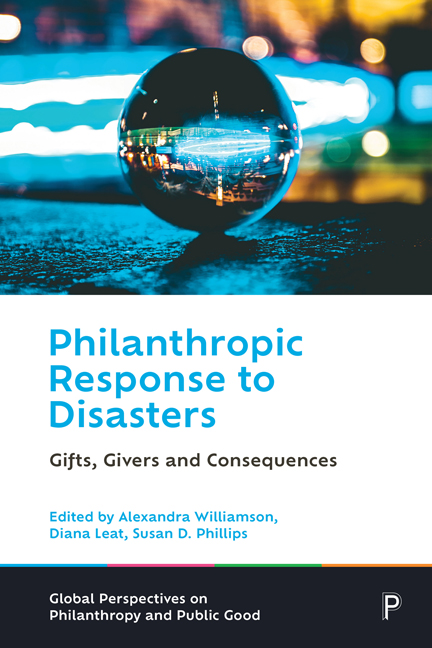Book contents
- Frontmatter
- Contents
- List of tables and figures
- Notes on contributors
- Series editors’ preface
- 1 Introduction
- 2 The public’s philanthropic response to disaster: plus ça change?
- 3 Disaster fundraising: readiness matters
- 4 Roles of philanthropic foundations as funders and distribution agents in disaster response
- 5 The private sector and disasters: from reactive response to disaster resilience
- 6 Fundraising, grantmaking and regulatory issues: regulating good in bad times
- 7 Doing good better: public policy for disaster philanthropy
- 8 Philanthropy’s place in community-based capacity development for disaster resilience
- 9 Nonprofit collaboration and coordination in disaster response: lessons from the 11 September recovery
- 10 The promise and reality of philanthropy in disasters
- 11 Conclusions and looking forward
- Index
10 - The promise and reality of philanthropy in disasters
Published online by Cambridge University Press: 17 January 2024
- Frontmatter
- Contents
- List of tables and figures
- Notes on contributors
- Series editors’ preface
- 1 Introduction
- 2 The public’s philanthropic response to disaster: plus ça change?
- 3 Disaster fundraising: readiness matters
- 4 Roles of philanthropic foundations as funders and distribution agents in disaster response
- 5 The private sector and disasters: from reactive response to disaster resilience
- 6 Fundraising, grantmaking and regulatory issues: regulating good in bad times
- 7 Doing good better: public policy for disaster philanthropy
- 8 Philanthropy’s place in community-based capacity development for disaster resilience
- 9 Nonprofit collaboration and coordination in disaster response: lessons from the 11 September recovery
- 10 The promise and reality of philanthropy in disasters
- 11 Conclusions and looking forward
- Index
Summary
In this chapter, I discuss some experiences on the intersection of disaster philanthropy in the aftermath of various disasters. While many of the lessons may be generalisable, it is important to acknowledge that the majority (although not all) of these responses have been in the United States, and the nature of the work has been focused on impacts to people and human systems. There are certainly more areas that can be covered in terms of geography affected, ecosystems impacted (natural versus human created) and types of hazards. But in working with and observing disaster response over the past two decades, the themes that emerge are constant, and transcend the limited illustrative examples provided below. That being said, context is among the most important facets of the disaster management cycle, and general themes should never be used to supplant the nuances in our communities that make each one unique and every response different.
Introduction
Disaster philanthropy and the response of nonprofits is an essential component of the disaster cycle. In some cases, it is a planned part of our response to and recovery from disasters. It can be the go-to resource for sheltering and feeding, and providing social services to those in need. Other times, it is unplanned and the overwhelming donations and volunteers showing up can be as much of a burden as a blessing. In fact, the notion of an abundance of inappropriate and unneeded donations is often referred to as the ‘second disaster’ (Nelan et al, 2019). Philanthropy is also increasingly a player in how we look at disaster preparedness and mitigation in our pre-disaster thinking, although the main focus is almost always immediately after the disaster strikes and responding to acute need.
Beyond the direct services provided, philanthropy and charitable work is also a way for ordinary people, near and far from the epicentre of the disaster, to provide assistance. Those far away can send needed items, or ideally cash (the most durable of donations), to assist those on the front lines and help meet the needs of survivors. Some people choose to volunteer their time to help coordinate donations and, in some cases, to deploy to disasters to provide direct assistance. In the affected communities, normal citizens and organisations also become responders, assisting those in their community who need help.
- Type
- Chapter
- Information
- Philanthropic Response to DisastersGifts, Givers and Consequences, pp. 201 - 212Publisher: Bristol University PressPrint publication year: 2023



